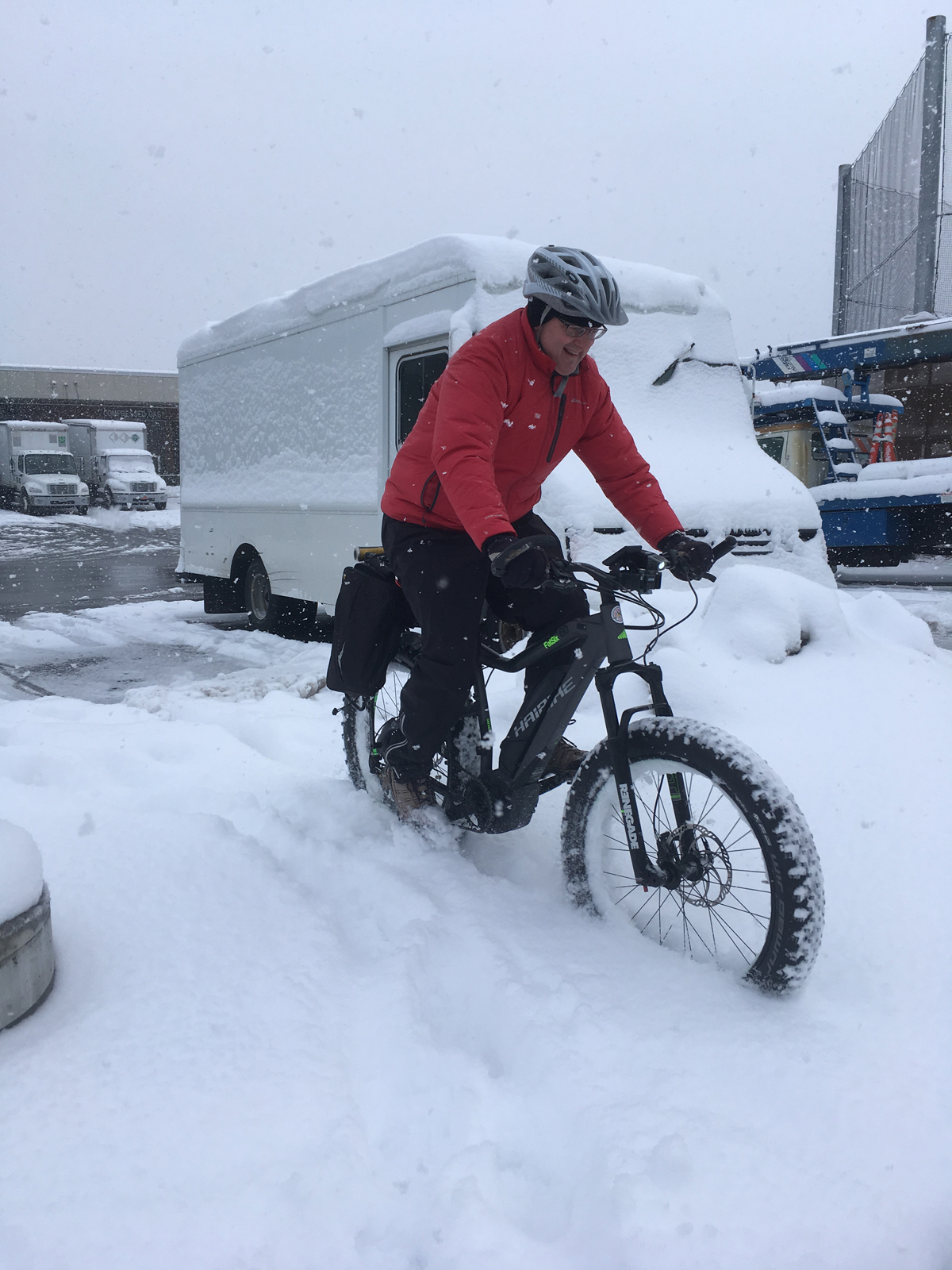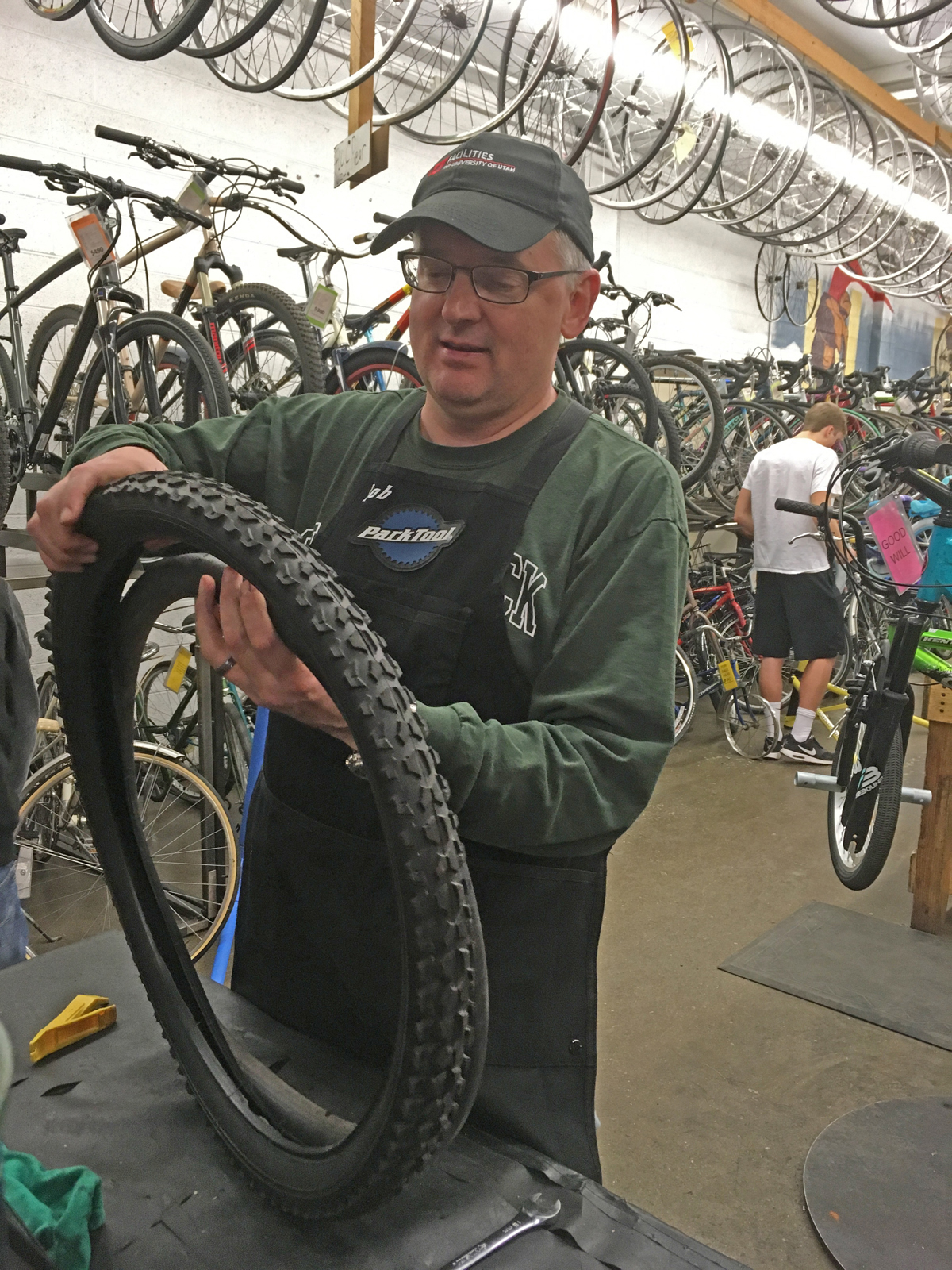To anyone that commutes to the University of Utah or to the medical centers, there are some issues, not insurmountable, but riding to and within the campus could be better. After reading the recent minutes from the Salt Lake City Bicycle Advisory Committee and meeting Bob Simonton, it appears that bicycle travel will be improving on campus.
[Editor’s Note: This article originally appeared in the March 2017 issue of Cycling West]
Cycling Utah: Bob, tell the readers a little about yourself.
Robert Simonton: My wife Anji and I live near the University of Utah, where I am the Director of Design and Construction. I belong to a family of Ducks, as Anji and both daughters, Sarah and Lydia, are all graduates from the University of Oregon. Anji has also spent most of her career working in Higher Education as a Director of Institutional Research. Sarah lives near Philadelphia with her husband Komeil. They are eagerly awaiting the birth of their first child this summer (2017). Lydia lives in Portland and works for a non-profit that aides blind athletes.

I am originally from Gettysburg PA. I have lots of great memories from my childhood cycling on the national park roads and exploring the famous sites. After college, I worked in construction management and traveled to projects in Delaware, New Jersey, Maryland, Virginia and Pennsylvania. In 1991, I took a job a Penn State’s Hershey Medical Center in Facilities Management that allowed for a much better life-work balance. In 2000, we moved to Eugene, Oregon, where I became the Assistant Vice Chancellor for Capital Programs, with the Oregon State Board of Higher Education. Since 2014, I have been with the University of Utah, and I currently manage a team specializing in infrastructure projects for the Planning, Design, and Construction Department.
C.U.: Why do you commute by bicycle? Tell me a little about your commute to the University and some of your bike commuting history and your commuter bikes.
R.S.: I believe having the freedom to venture out on a bike as a child has inspired me to keep riding throughout my life.
Since 1991, I have tried to commute to work by bike as weather permitted. It’s not only a great way to get exercise, but I always feel more focused and energized during the day. I have not always had the most expensive bikes, but I always install lights and a rear rack to hold my work clothing and lunch. Good puncture resistant tires and a heavy-duty lock are also important. When I started at Penn State’s Hershey Medical Center, my classic Miyata road bike was typically the only bike parked in the rack. I had a nice 28-mile round trip ride along back roads with rolling hills. On certain days, I would smell the aroma of chocolate and roasted nuts from the Hershey chocolate plant along my route.
While in Eugene, I had an 8-mile round-trip ride on bike paths through parks and quiet neighborhood streets. I also learned how to make myself waterproof with a wonderful material called Gore-Tex. I rode an inexpensive Giant Suede hybrid bike with fenders and a huge seat that was super comfortable. Eugene is a great place to ride and is typically ranked as one of the most bike friendly towns in the US. I was able to commute year round and use my bike to run errands, go shopping, and meet friends for coffee or lunch.
Now in Salt Lake City, my commute is only 2 miles round trip. My commuting bike has been a Specialized Crosstrail Pro Disc that I have also used on several bike tours. Thanks to the steep hills, I still get the workout of a much longer flat ride. I have never been a great hill climber, and have been known to joke about the hills getting steeper each year, blaming some sort of tectonic uplift of the mountains. To counter this hill phenomenon, I just purchased an electric assist fat bike. What a game changer! I can ride like I did 20 years ago. So, I find myself riding more places and going on longer rides.
The bike is Haibike, fat six model, made in Schweinfurt, Germany. With a mid-engine design and the battery integrated into the frame, the bike is well balanced and easy to ride. We also bought an e-bike for Anji, a Bulls Lacuba EVO-8, with a belt drive and Nexus 8-speed internal hub. Her bike is also a mid drive, but looks more like a Dutch bike, with a step-thru design. We are looking forward to more bike adventures together. Our goal is to ride the C&O Canal towpath trail this summer while in Pennsylvania visiting family.
C.U.: How would you compare your commuting experience in the various locales that you lived and rode?
R.S.: While in Pennsylvania, I did see investment in rails-to-trails type infrastructure, but not much improvement on public roads, other than signs that said; “Share the Road”. However, in Oregon, they definitely embrace cycling as a part of their culture. The numerous bike lanes and paths definitely played into my decision to move there. At the University of Oregon Campus, as parking lots were lost to the construction of new buildings, alternative transportation, like bus rapid transit and bike infrastructure, provided a cost effective solution to lost parking stalls.
In Salt Lake City, I see a community that is heading in the right direction with a bike master plan passed in 2015 and the addition of a bike share program. As we confront more traffic congestion and pollution, we can improve the quality of life by encouraging more people to try active transportation alternatives like biking.

C.U.: Your commute is roughly 2-miles round trip. Did you move to your home purposely for bike commuting? How does distance to work influence your commuting?
R.S.: Yes, living close to campus was a conscious choice for easy commuting and quality of life. It is so convenient to attend the many events offered by the University, including sporting events, concerts, plays, lectures, and dance performances.
However, there are so many other factors that need to be considered when thinking about a reasonable distance to commute by bike. For instance, when my 2 daughters were little, proximity to good schools was the priority.
Looking back on all of my various bicycle-commutes, the miles ranged from a maximum of 14 miles one way to my current 1-mile trip. But I think less of the miles and more of the overall commuting experience. My favorite commute was during a brief consulting job in Portland where I rode 8 miles each way along a bike path next to the Willamette River. The scenery was stunning, and I was joined by hundreds of other bike commuters. I had access to a bike valet service and shower facilities at my destination. All of the parts and pieces were in place for a safe and easy commute, and I felt like I belonged. Bike commuting seemed less like an alternative and more like an accepted norm where anyone could join in and experience it.
C.U.: Bob, tell me about what you are doing on campus that will help cyclists get around.
R.S.: In addition to my bike commuting, my position at the University allows me the opportunity to work on transportation planning projects, especially how we implement the University’s Bike Master Plan. Overall, the campus is a great place to ride but has certain areas that could use some improvement. Some of the projects that I am working on include:
- Adding bike ramps around stairs.
- Adding bike lanes and pathways along major access roads to campus.
- Including bike facilities in new buildings; showers and secure bike parking.
- Exploring an e-bike sharing program for students, faculty, and staff.
C.U.: What can my readers expect within the next year and within the next 5 years?
R.S.: The University has recently hired an Active Transportation Manager, Ginger Cannon, to help promote and prioritize projects that will create viable transportation options, like bike commuting. We are currently working on an annual capital funding plan to improve and expand the bike routes through campus, as outlined in the University’s Bike Master Plan. Ginger is also working on an e-bike purchase program for University employees and campus departments, where e-bike shops can offer bikes for sale at a discounted rate. Given the amount of road construction planned around campus this summer, an e-bike would be a fun way to avoid delays.
The University participates in planning initiatives by the city, county, UDOT, and UTA that address connectivity issues with the University. Recently we celebrated the completion of the Sunnyside Trail and the University to Downtown Bikeway, with marked routes showing easy, intermediate, and short/steep choices to connect the University and Downtown Salt Lake City. Also, UDOT plans to re-pave Mario Capecchi Drive this summer, and thanks to our input, will include bike lanes that will tie into a future bike/pedestrian path. We are also planning a Wasatch Drive project this summer to add bike lanes to that street. I would say that continued community support and having more bike commuters to campus is the key to getting more projects like these funded and implemented.

C.U.: I met you as a fellow volunteer at the Bike Collective. What motivated you to volunteer? What goals do you have as a volunteer?
R.S.: I try to do my part by improving the bike infrastructure and culture at the U of U and the greater community as a volunteer with the SLC Bike Collective. I feel a sense of accomplishment by fixing donated bikes to be put back into service and used by those less fortunate. I really enjoy the challenge of fixing bikes and sharing my mechanical knowledge with less experienced volunteers. As a kid in Gettysburg, having a bike was my ticket to explore the world around me. I think everyone should be given the opportunity to explore by bike within a community that embraces those aspirations.
C.U.: Bob, it has been a true pleasure to meet you and work with you at the Collective. I sincerely appreciate the work and effort that you are doing on behalf of the cyclists of Salt Lake City and beyond. Thank you!





